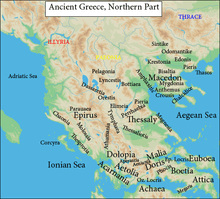Parauaea

Map showing the ancient regions of central, western and northern Greece
Parauaea (Greek: Παραυαία) was an ancient Greek region in Epirus.[1] The area was incorporated into Macedon in 350 BC as part of Upper Macedonia.[2][3] The Thesprotian[4] tribe inhabiting it was called Parauaioi (Greek: Παραυαῖοι). Parauaei[5] under[6] king Oroedus (Greek: Ὄροιδος) and 1000 Orestai, entrusted to Oreoedus by Antiochus, their king, had joined the Spartans under Cnemus during the 3rd year of the Peloponnesian war. Rhianus[7] (3rd century BC) calls them a Thesprotian nation, and so does Stephanus of Byzantium quoting Rhianus. Their name, Parauaioi meant, those dwelling beside Aous, a river in Epirus.
See also
References
- ↑ The Cambridge ancient history: The Hellenistic world, Part 2, by Frank William Walbank, 1989, ISBN 0-521-23446-8, page 461: "and Parauaea in the border country between Epirus and Macedonia"
- ↑ Plutarch, Pyrrhus (ed. Bernadotte Perrin), 6, "demanded as a reward for his alliance Stymphaea and Parauaea in Macedonia..."
- ↑ Aous flows, in the upper part A dictionary of Greek and Roman biography and mythology (ed. William Smith), "Amphilochia, and Ambracia, and likewise the districts of Tymphaea and Parauaea, which formed part of Macedonia itself. (Plut. Pyrrh. "
- ↑ Epirus: the geography, the ancient remains, the history and topography of ..." by Nicholas Geoffrey Lemprière Hammond, 1967, page 703, "The Parauaei and the Celaethi held their Thesprotian name from a period which goes back to a time before..."
- ↑ Thuc. 2.80
- ↑ PARAVAEI
- ↑ Rhianus Epic. Fragmenta, "Παραυαῖοι ἔθνος Θεσπρωτικόν"